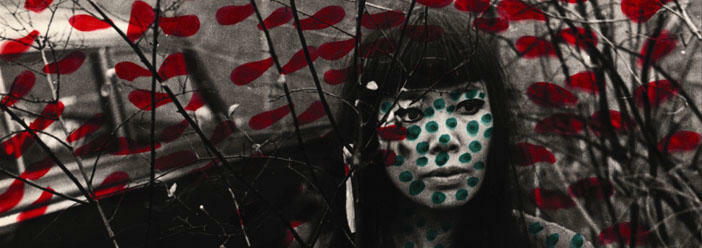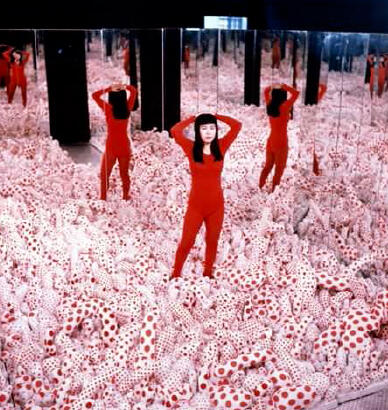Yayoi Kusama. A Journey to the Interior of Madness
Yayoi Kusama: Infinite Obsession, the first in-depth survey of the work of one of the most original and inventive artists of the postwar period to be presented in Latin America, was organized by Malba – Fundación Costantini and curated by Philip Larratt-Smith (Deputy Chief Curator, Malba, Buenos Aires) and Frances Morris (curator of Kusama’s retrospective at Tate Modern, London) in collaboration with the artist’s studio. It comprised over 100 carefully chosen works from 1950 to 2013, including paintings, works on paper, sculptures, videos, slideshows, and installation works.

A museum whose interior and exterior have been taken by the lysergic force of Yayoi Kusama (84) makes it possible to produce a chronicle of the exhibition without visiting it, just sitting on the entrance stairway, listening to the expectations of long lines of people who, escorted by polka dot trees, are waiting to go in. Or being attentive to the exciting rumors spread by the eyes of those who leave the show in ecstasy. We might also visit the exhibit with our eyes shut and perceive the brain vibrations. That would suffice. But it would be a shame.
On opening their eyes, visitors were faced with one of the most important walls of the central hall covered with large-format works which, one by one, sketched out the best dreams and the worst nightmares of an artist who daily confronts her madness with the help of pictorial materials, until it is time to rest in the psychiatric institution that embraces her every night. The daring palette in these works contrasted with the vital calmness of the Japanese creator. Especially if, on climbing the museum stairs and beginning the visit of the second floor, we recalled the same wild ascent that Kasuma lived during her passage through the USA, when a torrent of creation, orgies and corporal performances laid bare an uncontrollable personality.
The showrooms that lovingly hosted her earliest works and the installations from the 1960s were guarded by a storyboard that showed us the baby Yayoi (1936), the young woman with the threatening look, the Oriental woman who is the owner of the world but also a tenant of an unbearable vital vertigo, or a young octogenarian with raging red hair and a revolutionary peace. Her earliest works on display dated from the 1950s, and they already projected dots, lines, and a repressed need to simplify the extraordinary complexity of her art.
We found in these series and in those from the following decade a conceptualization of feelings such as nocturnality, community, and the networks that situate her in the same generation as the visionary artists of her time. Warhol clang to consumerism, or to HIV ahead of his time, and Kusama portrayed the notion of networks and communities against the dark background of her skepticism.
These aspects, as well as the hypnotic effect of speed in a congregation balanced by concern, referred us directly to the notions of the sublime posited by Arthur Danto in The Abuse of Beauty. The same effect was achieved by other components of the series Infinity Nets, whose title seems to be even more valid in times of computer science.
The following exhibition spaces where flaccid penises flourished referred us to the phallic potency of this artist through variations of clarity or hallucinogenic darkness. At this point of the tour visitors were under the impression that they were listening to Bach’s Goldberg Variations played by Glenn Gloud. Hearts beat faster and footsteps became more rhythmical. Works like Infinity Mirror Room – Phalli’s Field (1965/2013) or Walking in the sea of death (1981) complicated the spectator’s understanding.
Then came a haven of rooms devoted to the screening of public performances and documentary resources which, like the artist’s life itinerary, referred to her return to her native Japan and the concern about her mental health.
The next works alluded to the multilingual and ageless potency of an artist who breaks the understanding between the spectator and the work to immerse us in environments that break the limit between the personal and the public spheres. We entered inside the artist, we penetrated her, and the dots (symbols of madness par excellence) deceived the eye in works with a marked Pop sense. These works by “the modern Alice in Wonderland” (according to the artist herself) were celebrated by adults and understood by the happiest children in all of the world’s museums. This is proved by more than 120,000 visitors who appropriated the artist’s intimate everyday life by participating in an act of mental voyeurism that remains shameless.
The frenzy of the exhibition Infinite Obsession in Buenos Aires was comparable to the furious participation of visitors in the last gallery, where each person could apply a few multicolored dots which were received when buying the entrance ticket. While the poorest and the richest artist in present-day art declared she has suffered her art “economically and psychologically”, the public became Yayoi.
Perhaps this is just too many people inside a single person to be able to bear it with some sanity.
-
 Infinity Mirror Room – Phalli’s Field [Sala de espejos del infinito - Campo de falos], 1965/2013 - Tela rellena y cosida, paneles de madera y espejos
Infinity Mirror Room – Phalli’s Field [Sala de espejos del infinito - Campo de falos], 1965/2013 - Tela rellena y cosida, paneles de madera y espejos
250 x 455 x 455 cm - Cortesía Ota Fine Arts, Tokyo; Victoria Miro - Gallery, London; David Zwirner, New York; y Yayoi Kusama Studio.
© Yayoi Kusama




